阅读理解-第十五篇 肋生双翅机器人学飞行
五年级2022年西师大下册语文课内阅读理解真题(含答案)

五年级2022年西师大下册语文课内阅读理解真题(含答案)班级:________ 姓名:________ 时间:________一、阅读课内外片段及资料,完成练习。
人在奋力奔跑的时候,最大速度能够达到44千米每小时。
这个速度跟鸵鸟比起来差远了——鸵鸟奔跑的最大速度约72千米每小时。
在两条腿的动物里面,鸵鸟应该算是奔跑的世界冠军。
比鸵鸟跑得更快的动物就要数猎豹了。
猎豹奔跑的最大速度可达110千米每小时。
猎豹才是陆地上跑得最快的动物。
但是游隼向下俯冲时的速度更快,超过320千米每小时。
这个速度是汽车在高速公路上飞速行驶时速度的两到三倍。
它俯冲时的速度比任何一种动物奔跑时速度都要快。
不过,游隼还是没有飞机飞行的速度快。
在喷气式飞行的高度,声音传播的速度大约是1050千米每小时,而一些高速喷气式飞机的飞行速度是声速的数倍。
如果你对着一个以超音速移动的人大喊,他是什么都听不见的。
因为声音根本追不上他。
乘坐喷气式飞机去旅行,速度绝对是够快的了。
但是,如果你想到月球上去,就需要搭乘速度更快的工具了。
对!我们需要一枚火箭。
为了摆脱地心引力,飞到浩瀚的太空中,火箭的速度要比喷气式飞机的速度快得多才行。
火箭的最大速度能达到4万千米每小时,是声速的30多倍。
进入太空之后,即使关掉发动机,火箭仍可以继续前进。
(资料)游隼,一种中型猛兽,主要在空中捕食。
它大多数时候都在空中飞翔巡猎,发现猎物时首先快速升上高空,占领制高点,然后以每秒钟75——100米的速度,近似垂直地从高空俯冲而下。
游隼的俯冲捕猎本领不是天生就会的,它具有自然界罕见的教授雏鸟捕食技巧的行为。
1.文中提到了三种动物,其中陆地上的奔跑冠军是________。
火箭飞到太空中,最大速度能达4万千米每小时,这样设计的目的是__________________。
2.由“资料衔接”可知,游隼在空中发现猎物后不降速度反升的原因是()A.和猎物比速度B.要占领制高点C.为了空中捕食D.教小游隼本领3.文中画横线的句子主要运用____________,___________的方法来说明游隼没有飞机飞行速度快。
六年级语文下学期阅读理解课后提升训练题精编及答案苏教版
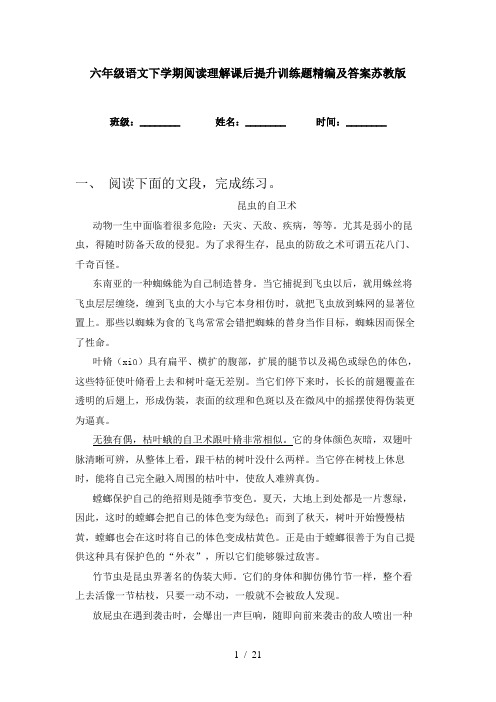
六年级语文下学期阅读理解课后提升训练题精编及答案苏教版班级:________ 姓名:________ 时间:________一、阅读下面的文段,完成练习。
昆虫的自卫术动物一生中面临着很多危险:天灾、天敌、疾病,等等。
尤其是弱小的昆虫,得随时防备天敌的侵犯。
为了求得生存,昆虫的防敌之术可谓五花八门、千奇百怪。
东南亚的一种蜘蛛能为自己制造替身。
当它捕捉到飞虫以后,就用蛛丝将飞虫层层缠绕,缠到飞虫的大小与它本身相仿时,就把飞虫放到蛛网的显著位置上。
那些以蜘蛛为食的飞鸟常常会错把蜘蛛的替身当作目标,蜘蛛因而保全了性命。
叶脩(xiū)具有扁平、横扩的腹部,扩展的腿节以及褐色或绿色的体色,这些特征使叶脩看上去和树叶毫无差别。
当它们停下来时,长长的前翅覆盖在透明的后翅上,形成伪装,表面的纹理和色斑以及在微风中的摇摆使得伪装更为逼真。
无独有偶,枯叶蛾的自卫术跟叶脩非常相似。
它的身体颜色灰暗,双翅叶脉清晰可辨,从整体上看,跟干枯的树叶没什么两样。
当它停在树枝上休息时,能将自己完全融入周围的枯叶中,使敌人难辨真伪。
螳螂保护自己的绝招则是随季节变色。
夏天,大地上到处都是一片葱绿,因此,这时的螳螂会把自己的体色变为绿色;而到了秋天,树叶开始慢慢枯黄,螳螂也会在这时将自己的体色变成枯黄色。
正是由于螳螂很善于为自己提供这种具有保护色的“外衣”,所以它们能够躲过敌害。
竹节虫是昆虫界著名的伪装大师。
它们的身体和脚仿佛竹节一样,整个看上去活像一节枯枝,只要一动不动,一般就不会被敌人发现。
放屁虫在遇到袭击时,会爆出一声巨响,随即向前来袭击的敌人喷出一种混合着过氧化氢及醌(kūn)醇(chún)的臭液。
待敌人从巨响和臭液中清醒过来时,放屁虫早就逃得无影无踪了。
步甲虫遭遇敌害时,就会用双足往地上一撑,后腹部对准敌人,连连发炮,喷射出一种具有很强刺激性臭味的气体,将敌人熏得失去战斗力。
步甲虫就是靠这种“化学武器”对付来犯之敌。
飞蛾变身半机械飞行器阅读理解附答案

飞蛾变身半机械飞行器阅读理解附答案飞蛾变身半机械飞行器①下次,当你注意到身边有只蜂鸟或是蜻蜓在扇动翅膀轻盈飞舞时,你可要小心了,因为这些小鸟或昆虫或许也在暗中窥视你。
据美国媒体披露,美国国防部已投入数百万美元,应用仿生学原理研发微型侦察飞行器。
经过多年研发,鸟类和昆虫间谍技术逐步成熟,它们能携带摄像机和录音装置,潜入侦查区域录下视频或频。
②“纳米蜂鸟”翼展16.51厘米,重量与一节5号电池相近,虽然样子不起眼,但它的功能已经很完备,“蜂鸟”相当于一个迷你版的无人侦察机,腹部装有微型摄像机,飞行速度能达17公里/小时。
③除了让飞行器变得越来越小外,还有研究人员打算走另一条“捷径”,将活生生的昆虫变成半机械的飞行间谍。
美国国防部先进研究项目局的科学家正在实验,是否可以在昆虫变态发育过程中植入摄像头或传感器,并通过电刺激它们的翅膀控制其飞行。
这种经过改造的昆虫间谍,就能大批出动,飞到各个角落为军方收集情报。
④昆虫学家认为,这样的改造方案.......并非异想天开,但要改变昆虫亿万年进化所得的习性并不容易。
英国牛津大学教授乔治•麦克加文指出:“成年昆虫生存的目的只有一个:产卵繁殖。
要改造昆虫就得重新给它制定行为模式。
”⑤作为DARPA“混合微电子昆虫”项目的一部分,美国康奈尔大学的研究人员已经成功改造了烟草天蛾。
烟草天蛾的幼虫变成蛹后被植入一个微电子传感器,蛹成熟后变成寿命相对较长的蛾子。
烟草天蛾们体内的传感器就能控制其肌肉,实现远程操纵烟草天蛾飞行。
⑥虽然在实验中实现了对昆虫的控制,但科学家面临一个现实问题是植入芯片的重量。
美国加州大学伯克利分校的科学家也在两种甲虫的身上进行类似尝试:微电子系统被植入甲虫体内四个位置,尽管能精确控制飞行方向,但由于芯片的重量过重,第一种实验对象绿金龟根本飞不起来,只有第二种名叫拖瓜塔花金龟的大型甲虫能顺利起飞,最长飞行时间也不过1分钟。
这种非洲甲虫最大能长到人的手掌那么大,是甲虫家族中的大力士。
统编版四年级语文上册第七单元阅读能力达标训练-5(有答案)
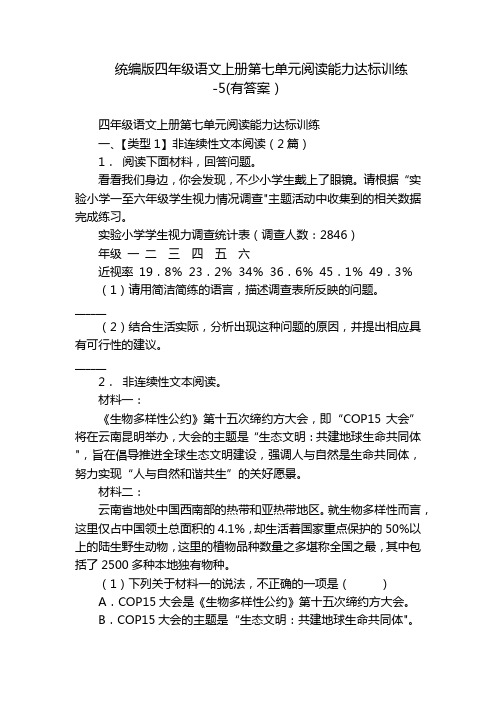
统编版四年级语文上册第七单元阅读能力达标训练-5(有答案)四年级语文上册第七单元阅读能力达标训练一、【类型1】非连续性文本阅读(2篇)1.阅读下面材料,回答问题。
看看我们身边,你会发现,不少小学生戴上了眼镜。
请根据“实验小学一至六年级学生视力情况调查"主题活动中收集到的相关数据完成练习。
实验小学学生视力调查统计表(调查人数:2846)年级一二三四五六近视率19.8%23.2%34%36.6%45.1%49.3%(1)请用简洁简练的语言,描述调查表所反映的问题。
______(2)结合生活实际,分析出现这种问题的原因,并提出相应具有可行性的建议。
______2.非连续性文本阅读。
材料一:《生物多样性公约》第十五次缔约方大会,即“COP15大会”将在云南昆明举办,大会的主题是“生态文明:共建地球生命共同体",旨在倡导推进全球生态文明建设,强调人与自然是生命共同体,努力实现“人与自然和谐共生”的关好愿景。
材料二:云南省地处中国西南部的热带和亚热带地区。
就生物多样性而言,这里仅占中国领土总面积的4.1%,却生活着国家重点保护的50%以上的陆生野生动物,这里的植物品种数量之多堪称全国之最,其中包括了2500多种本地独有物种。
(1)下列关于材料一的说法,不正确的一项是()A.COP15大会是《生物多样性公约》第十五次缔约方大会。
B.COP15大会的主题是“生态文明:共建地球生命共同体"。
C.COP15大会旨在倡导推进全国生态文明建设。
D.COP15大会的愿景是“人与自然和谐共生”。
(2)结合材料二可知,COP15大会在云南举办的原因是()A.云南仅占中国领土总面积的4.1%。
B.云南的动物物种多,植物品种数量多。
C.云南保护生物多样性成就大。
D.云南地处中国西南部的热带和亚热带地区。
(3)对下图COP15大会会标的含义,描述不正确的是()A.水是生命之源,是万物之源。
B.用甲骨文剪纸和印章体现源远流长的中国文化。
四年级语文上册课外阅读专项练习

四年级语文上册课外阅读专项练习1. 阅读下文,回答问题有一天,小男孩儿玩儿玩具时,顺手把锡兵移到窗台上。
忽然一阵风刮来,窗户开了,锡兵一个倒栽葱从三楼摔了下去。
他倒立在自己的钢盔中,腿直直地立起来,刺刀插在街上的石缝里。
天开始下起了雨,越下越大,最后简直是倾盆大雨了。
锡兵倒立着,水流哗哗地冲刷着他的身体,好像要把他带走。
可是他依然一动不动。
他默默地想着那位跳舞的小姑娘__她还能在那儿站多久呢__她身体那么柔弱__一定需要我的保护__我一定能够回去的__主人一定会来找我的__想到这里,锡兵的脸上露出了微笑。
(1)在文中横线处加上标点符号。
他默默地想着那位跳舞的小姑娘______她还能在那儿站多久呢______她身体那么柔弱______一定需要我的保护______我一定能够回去的______主人一定会来找我的______(2)在锡兵遇到危险的时候,他是怎么想的?(3)从锡兵的身上我们看到一种怎样的品质?2. 背写课文,回答问题。
王戎七岁,尝与诸小儿游,看道边李树多子折枝。
诸儿竞走取之,唯戎不动。
人问之,答曰:“树在道边而多子,此必苦李。
”取之,信然。
(1)王戎“看道边李树多子折枝”,此时,他会想些什么?(用文中的话回答)(2)王戎与诸小儿想比有哪些过人之处?()(多项选择)A.仔细观察B.善于根据有关现象进行推理判断C.会对脑筋D.先人后己,懂得谦让3. 阅读下文《富饶的西沙群岛》,回答问题富饶的西沙群岛(节选)西沙群岛一带海水五光十色,瑰丽无比:有深蓝的,淡青的,浅绿的,杏黄的。
一块块,一条条,相互交错着。
因为海底高低不平,有山崖,有峡谷,海水有深有浅,从海面看,色彩就不同了。
海底的岩石上长着各种各样的珊瑚,有的像绽开的花朵,有的像分枝的鹿角。
海参到处都是,在海底懒洋洋地蠕动。
大龙虾全身披甲,划过来,划过去,样子挺威武。
(1)文中“______”一词概括说明了海水颜色多,请找出表示海水色彩不同的原因的句子______。
人类的老师课文同步练习答案

人类的老师课文同步练习答案《人类的老师》课文通过生动的实例,介绍了科学家从蜻蜓、鲸等动物身上得到启示,有所发明、有所创造。
下面小编就跟大家聊聊关于人类的老师同步练习答案吧,希望能帮助到大家。
人类的老师同步练习答案一、辨字组词。
锅盖祸害担任坦克勺子平均山川教训二、用“ \ ”画去带点字不正确的读音。
qiáng jìn báo zhàn mú qiào三、用带点词语造句。
示例:1.由于下雪路面滑,有一些行人不幸跌倒。
2.他之所以成绩出众,是因为平时刻苦地学习。
四、根据课文内容填空。
1.仿生学科普文飞机设计轮船设计建筑设计2.自然界会跳跃的越野汽车外壳坚固的坦克鱼儿潜水艇会变色的蜥蜴【拓展提高】五、阅读短文,完成练习。
1.攻废飘发现2.体会可是,他把老师的话当作耳旁风3.第一段:富尔顿小时候只爱画画不爱读书,把老师的话当作耳旁风。
第二段:富尔顿从一次划船经历中领悟了学习科学知识的重要性。
第三段:从此,富尔顿发奋学习,长大后成为第一艘蒸汽轮船的的发明者。
《人类的老师》课文原文科学家们研究了蝙蝠夜间飞行的秘密,从中得到启示,发明了雷达。
可以说蝙蝠是人类的“老师”。
其实,自然界里可以充当人类“老师”的生物何止蝙蝠一种。
人类自古就想像鸟儿一样飞上蓝天。
科学家认真研究了鸟类飞行的原理,终于在1903年发明了飞机。
三十年以后,由于飞机的速度不断提高,经常发生机翼因剧烈抖动而破碎的现象,造成机毁人亡的惨祸。
过了好久,人类才找到了防止这类事故的方法。
其实蜻蜓早就解决了这个问题。
原来,每只蜻蜓的翅膀末端,都有一块比周围略重一些的厚斑,这就是防止翅膀颤抖的关键。
要是早知道这一点,科学家可以少花多少时间和精力呀!现在的飞机设计师吸取了这一教训,注意研究苍蝇、蚊子、蜜蜂等的飞行特点,造出了许多具有各种优良性能的新式飞机。
从前,在大海中航行的轮船,虽然船头是尖尖的,但总是开不快。
【配套K12】中考语文专题复习 第三部分 阅读 专题八 课时讲解
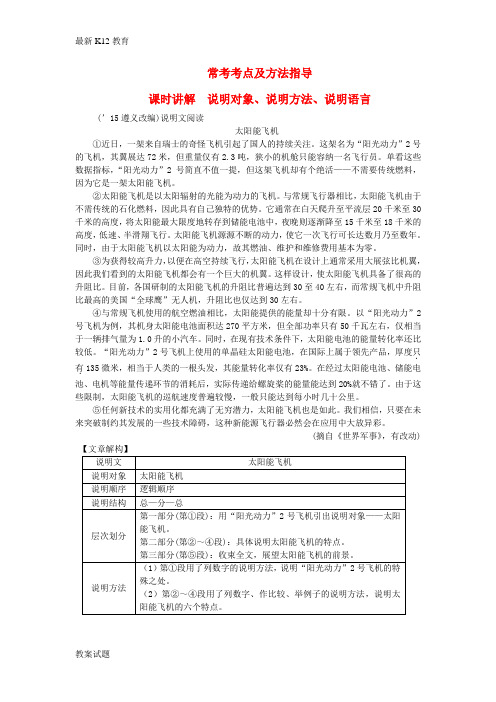
最新K12教育教案试题常考考点及方法指导课时讲解说明对象、说明方法、说明语言(’15遵义改编)说明文阅读太阳能飞机①近日,一架来自瑞士的奇怪飞机引起了国人的持续关注。
这架名为“阳光动力”2号的飞机,其翼展达72米,但重量仅有2.3吨,狭小的机舱只能容纳一名飞行员。
单看这些数据指标,“阳光动力”2号简直不值一提,但这架飞机却有个绝活——不需要传统燃料,因为它是一架太阳能飞机。
②太阳能飞机是以太阳辐射的光能为动力的飞机。
与常规飞行器相比,太阳能飞机由于不需传统的石化燃料,因此具有自己独特的优势。
它通常在白天爬升至平流层20千米至30千米的高度,将太阳能最大限度地转存到储能电池中,夜晚则逐渐降至15千米至18千米的高度,低速、半滑翔飞行。
太阳能飞机源源不断的动力,使它一次飞行可长达数月乃至数年。
同时,由于太阳能飞机以太阳能为动力,故其燃油、维护和维修费用基本为零。
③为获得较高升力,以便在高空持续飞行,太阳能飞机在设计上通常采用大展弦比机翼,因此我们看到的太阳能飞机都会有一个巨大的机翼。
这样设计,使太阳能飞机具备了很高的升阻比。
目前,各国研制的太阳能飞机的升阻比普遍达到30至40左右,而常规飞机中升阻比最高的美国“全球鹰”无人机,升阻比也仅达到30左右。
④与常规飞机使用的航空燃油相比,太阳能提供的能量却十分有限。
以“阳光动力”2号飞机为例,其机身太阳能电池面积达270平方米,但全部功率只有50千瓦左右,仅相当于一辆排气量为1.0升的小汽车。
同时,在现有技术条件下,太阳能电池的能量转化率还比较低。
“阳光动力”2号飞机上使用的单晶硅太阳能电池,在国际上属于领先产品,厚度只.有.135微米,相当于人类的一根头发,其能量转化率仅有23%。
在经过太阳能电池、储能电池、电机等能量传递环节的消耗后,实际传递给螺旋桨的能量能达到20%就不错了。
由于这些限制,太阳能飞机的巡航速度普遍较慢,一般只能达到每小时几十公里。
⑤任何新技术的实用化都充满了无穷潜力,太阳能飞机也是如此。
《昆虫般大小的机器人》阅读及答案
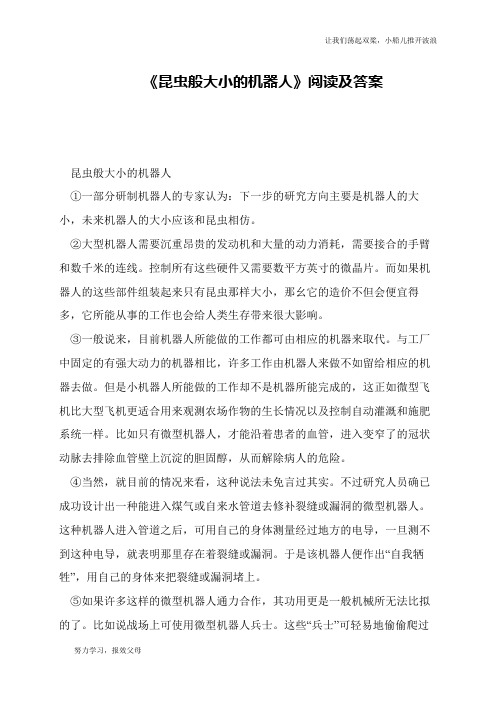
让我们荡起双桨,小船儿推开波浪
努力学习,报效父母《昆虫般大小的机器人》阅读及答案
昆虫般大小的机器人
①一部分研制机器人的专家认为:下一步的研究方向主要是机器人的大小,未来机器人的大小应该和昆虫相仿。
②大型机器人需要沉重昂贵的发动机和大量的动力消耗,需要接合的手臂和数千米的连线。
控制所有这些硬件又需要数平方英寸的微晶片。
而如果机器人的这些部件组装起来只有昆虫那样大小,那幺它的造价不但会便宜得多,它所能从事的工作也会给人类生存带来很大影响。
③一般说来,目前机器人所能做的工作都可由相应的机器来取代。
与工厂中固定的有强大动力的机器相比,许多工作由机器人来做不如留给相应的机器去做。
但是小机器人所能做的工作却不是机器所能完成的,这正如微型飞机比大型飞机更适合用来观测农场作物的生长情况以及控制自动灌溉和施肥系统一样。
比如只有微型机器人,才能沿着患者的血管,进入变窄了的冠状动脉去排除血管壁上沉淀的胆固醇,从而解除病人的危险。
④当然,就目前的情况来看,这种说法未免言过其实。
不过研究人员确已成功设计出一种能进入煤气或自来水管道去修补裂缝或漏洞的微型机器人。
这种机器人进入管道之后,可用自己的身体测量经过地方的电导,一旦测不到这种电导,就表明那里存在着裂缝或漏洞。
于是该机器人便作出“自我牺牲”,用自己的身体来把裂缝或漏洞堵上。
⑤如果许多这样的微型机器人通力合作,其功用更是一般机械所无法比拟的了。
比如说战场上可使用微型机器人兵士。
这些“兵士”可轻易地偷偷爬过。
部编版语文六年级下册 第五单元 专项训练 课外阅读(含答案)
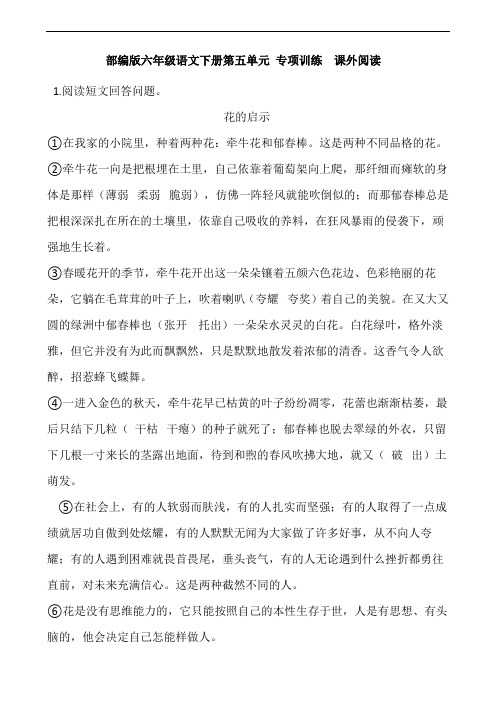
部编版六年级语文下册第五单元专项训练课外阅读1.阅读短文回答问题。
花的启示①在我家的小院里,种着两种花:牵牛花和郁春棒。
这是两种不同品格的花。
②牵牛花一向是把根埋在土里,自己依靠着葡萄架向上爬,那纤细而瘫软的身体是那样(薄弱柔弱脆弱),仿佛一阵轻风就能吹倒似的;而那郁春棒总是把根深深扎在所在的土壤里,依靠自己吸收的养料,在狂风暴雨的侵袭下,顽强地生长着。
③春暖花开的季节,牵牛花开出这一朵朵镶着五颜六色花边、色彩艳丽的花朵,它躺在毛茸茸的叶子上,吹着喇叭(夸耀夸奖)着自己的美貌。
在又大又圆的绿洲中郁春棒也(张开托出)一朵朵水灵灵的白花。
白花绿叶,格外淡雅,但它并没有为此而飘飘然,只是默默地散发着浓郁的清香。
这香气令人欲醉,招惹蜂飞蝶舞。
④一进入金色的秋天,牵牛花早已枯黄的叶子纷纷凋零,花蕾也渐渐枯萎,最后只结下几粒(干枯干瘪)的种子就死了;郁春棒也脱去翠绿的外衣,只留下几根一寸来长的茎露出地面,待到和煦的春风吹拂大地,就又(破出)土萌发。
⑤在社会上,有的人软弱而肤浅,有的人扎实而坚强;有的人取得了一点成绩就居功自傲到处炫耀,有的人默默无闻为大家做了许多好事,从不向人夸耀;有的人遇到困难就畏首畏尾,垂头丧气,有的人无论遇到什么挫折都勇往直前,对未来充满信心。
这是两种截然不同的人。
⑥花是没有思维能力的,它只能按照自己的本性生存于世,人是有思想、有头脑的,他会决定自己怎能样做人。
⑦亲爱的朋友,你喜欢哪种人,究竟做哪种人呢?(1)从文中括号里各选取一处最合适的词,用横线标出。
_____________________________________________________________________ (2)从文中找出下面几个词语的反义词,对应写在下面:扎实——________;坚强——________;勇往直前——________。
(3)判断一下,下面对句子"牵牛花开出了一朵朵镶着五颜六色花边、色彩艳丽的花朵"的缩句练习中,哪一句最合适,在句后括号中用"√"表示出来。
折翅飞翔阅读答案

折翅飞翔阅读答案【篇一:折翅后的翱翔阅读】>在辽阔的亚马逊平原上,生活着一种叫雕鹰的雄鹰,它有“飞行之王”的称号.它的飞行时间之长、速度之快、动作之敏捷,堪称鹰中之最,被它发现的小动物,一般都难逃脱它的捕捉.但谁能想到那壮丽的飞翔后面却蕴含着滴血的悲壮?当一只幼鹰出生后,没享受几天舒服的日子,就要经受母亲近似残酷的训练,在母鹰的帮助下,幼鹰没多久就能独自飞翔,但这只是第一步,因为这种飞翔只比爬行好一点.幼鹰需要成百上千次的训练,否则,就不能获得母亲口中的食物.第二步,母鹰把幼鹰带到高处,或树边或悬崖上,然后把它们摔下去,有的幼鹰因胆怯而被母亲活活摔死.但母鹰不会因此而停止对它们的训练,母鹰深知:不经过这样的训练,孩子们就不能飞上高远的蓝天,即使能,也难以捕捉到食物进而被饿死.第三步则充满着残酷和恐怖,那些被母亲推下悬崖而能胜利飞翔的幼鹰将面临着最后的,也是最关键、最艰难的考验,因为它们那正在成长的翅膀会被母鹰残忍地折断大部分骨骼,然后再次从高处推下,有很多幼鹰就是在这时成为飞翔悲壮的祭品,但母鹰同样不会停止这“血淋淋”的训练,因为它眼中虽然有痛苦的泪水,但同时也在构筑着孩子们生命的蓝天.有的猎人动了恻隐之心,偷偷地把一些还没来得及被母鹰折断翅膀的幼鹰带回家里喂养.但后来猎人发现那被喂养长大的雕鹰至多飞到房屋那么高便要落下来.那两米多长的翅膀已成为累赘.原来,母鹰“残忍”地折断幼鹰翅膀中的大部分骨骼,是决定幼鹰未来能否在广袤的天空中自由翱翔的关键所在.雕鹰翅膀骨骼的再生能力很强,只要在被折断后仍能忍着剧痛不停地振翅飞翔,使翅膀不断地充血,不久便能痊愈,而痊愈后翅膀则似神话中的凤凰一样死后重生,将能长得更加强健有力.如果不这样,雕鹰也就失去了这仅有的一个机会,它也就永远与蓝天无缘.没有谁能帮助雕鹰飞翔,除了它自己.我们每个人都拥有自己辽阔而美丽的蓝天,也都拥有一双为蓝天作准备的翅膀,那就是激情、意志、勇气和希望,但我们的翅膀也同样常会被折断,也同样常会变得疲软无力,如果这样,我们能忍受剧痛拒绝怜悯,永不坠落地飞翔吗? 解释词语堪称怜悯1.文中《这样》指翅膀指2母鹰这样孙连雏鹰:首先 ,接着 ,最后读完文章你有什么感受(不少于30字,至少从两方面说)堪称:能够称的上怜悯:怜惜,爱惜文本中这样是指:要经历成千上百次的艰难训练就要活尖摔死也要继续下去翅膀是指:生存下来本领母鹰这样训练雏鹰:首先帮助它们独立飞翔,接着带它们去或树边或悬崖上,然后把它们摔下去,最后它们那正在成长的翅膀会被母鹰残忍地折断大部分骨骼,然后再次从高处推下读完文章的感觉是:(1)无论是人还是动物要想生存下去必须要有一技之长,优胜劣汰,适者生存永过远都是真理,不经历磨练就永远不会变的坚强.(2)母鹰对雏鹰是爱是博大的,它们明白要想让孩子更好的生存下去就必须让孩子们去面对一切的困难.只有雏鹰真正有了飞翔能力,它们才能做自由自的翱翔于它们的天空,它们才会变成真正的鹰.【篇二:六年级语文试卷】txt>1.用钢笔写句子,要求正确、规范、美观,注意行款。
飞行之王-蜻蜓阅读理解及参考答案
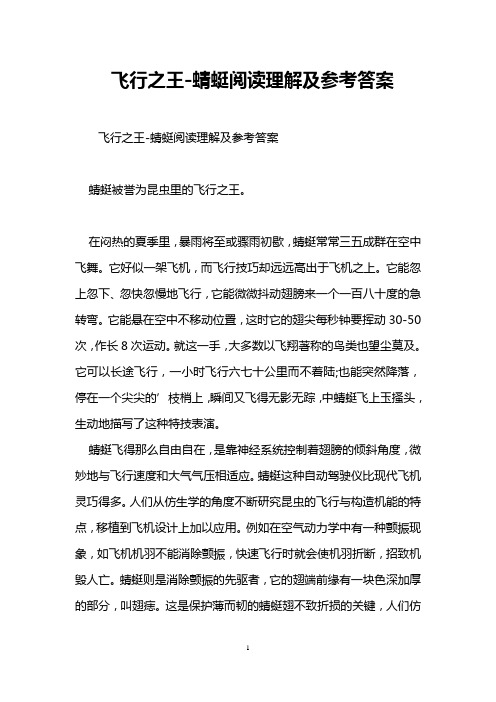
飞行之王-蜻蜓阅读理解及参考答案飞行之王-蜻蜓阅读理解及参考答案蜻蜓被誉为昆虫里的飞行之王。
在闷热的夏季里,暴雨将至或骤雨初歇,蜻蜓常常三五成群在空中飞舞。
它好似一架飞机,而飞行技巧却远远高出于飞机之上。
它能忽上忽下、忽快忽慢地飞行,它能微微抖动翅膀来一个一百八十度的急转弯。
它能悬在空中不移动位置,这时它的翅尖每秒钟要挥动30-50次,作长8次运动。
就这一手,大多数以飞翔著称的鸟类也望尘莫及。
它可以长途飞行,一小时飞行六七十公里而不着陆;也能突然降落,停在一个尖尖的’枝梢上,瞬间又飞得无影无踪,中蜻蜓飞上玉搔头,生动地描写了这种特技表演。
蜻蜓飞得那么自由自在,是靠神经系统控制着翅膀的倾斜角度,微妙地与飞行速度和大气气压相适应。
蜻蜓这种自动驾驶仪比现代飞机灵巧得多。
人们从仿生学的角度不断研究昆虫的飞行与构造机能的特点,移植到飞机设计上加以应用。
例如在空气动力学中有一种颤振现象,如飞机机羽不能消除颤振,快速飞行时就会使机羽折断,招致机毁人亡。
蜻蜓则是消除颤振的先驱者,它的翅端前缘有一块色深加厚的部分,叫翅痣。
这是保护薄而韧的蜻蜓翅不致折损的关键,人们仿照翅痣,在飞机机羽上设计了加厚部分,于是战胜了颤振,保证了快速型飞机的安全。
1、蜻蜓被誉为飞行之王是因为什么?(3分)2 、人类从蜻蜓的翅痣得到启示并运用到飞机设计的原理上,解决了什么实际问题?(3分)3、看了文段后,你从日常生活中突发异想,也想搞个小发明,简单说说你的想法。
(3分)参考答案:1、会表演各种飞行特技2、人们仿照翅痣,在飞机机羽上设计了加厚部分,于是战胜了颤振,保证了快速型飞机的安全。
3、略【飞行之王-蜻蜓阅读理解及参考答案】相关文章:1.2.3.4.5.6.7.8.。
《御风飞行》说明文阅读答案

《御风飞行》说明文阅读答案《御风飞行》说明文阅读答案说明文的阅读在中考和高考中都占有比较大的比重,如何掌握说明文的阅读技巧,提高说明文的阅读能力,快速完成说明文的阅读,掌握其阅读方法尤为重要。
今天,小编给大家带来御风飞行阅读答案,希望通过此分享,能对提高同学们的说明文阅读能力有所帮助。
御风飞行当你在花园里驻足观察那些胖胖的蜜蜂在花丛中起起落落,或者在厨房手拿苍蝇拍对着狡猾的苍蝇无可奈何时,你一定认同以下观点:把飞行家这个名词冠于昆虫身上是恰如其分的,昆虫不仅是地球上规模最大的飞行家族,也是最早掌握这项技术的先驱者。
地球上的第一次飞行是个什么场景?这一历史性的是时刻早已消失在岩层之中。
不过,当年第一批飞行者的后代仍然活跃在我们的星球上,他们就是蜉蝣。
蜉蝣这种生物大多数时间生活在水中,以藻类为食,当它们准备好繁殖,便爬出水面,在水边的植物上蜕皮,成为有翅的成虫。
这些获得新生的小虫子并不急于飞行,多数时候会聚集在水面上,伸展双翅,在微风的吹拂下于水面上滑行。
当时机成熟,便风中舞动,在空中完成婚配。
不久,雌虫产卵,刚刚脱离水面不过几十小时的蜉蝣们再次回落水中,这也意味着它们个体生命的终结。
目前,多数昆虫学家认为,最早的昆虫也像蜉蝣一样,是从水面滑行演化到飞行的,最早的翅应该是风帆,而非机翼。
昆虫的翅是一个工程学奇迹:一片丁质的薄层,没有任何骨骼和肌肉的支撑。
几丁质这种物质本身柔软而坚韧,就连碳纤维复合材料都无法与之相比。
几丁质中贯穿着翅脉,它们是液压管道,正是这些液压管道让昆虫的翅膀有了足够的刚性来应对飞行是巨大的应力考验。
与鸟、蝙蝠翅膀一样,昆虫翅膀的.剖面上端弯曲,下端平直,这使得空气流过翼面时产生升力。
昆虫与其他其他飞行动物的标志性区别,在于它们扇动翅膀时高得惊人的速度蜻蜓一般为每秒200次,而蚊子和马蜂则能高达每秒1000次。
不仅如此,如果逐格回放高速摄像机拍摄的昆虫飞行影像,你会惊奇地发现,昆虫扑翼飞行可不简单是上下运动,从侧面观察,昆虫的翅膀其实是在画八字形。
语文版六年级下册语文短文阅读提升练习及答案

语文版六年级下册语文短文阅读提升练习及答案一、阅读短文,回答问题。
勇气叩响成功的大门听说英国皇家学院公开张榜为大名鼎鼎的教授戴维选拔科研助手,年轻的书籍装订工人法拉第激动不已,赶快到选拔委员会报了名。
但临近选拔考试的前一天,法拉第被意外通知取消他的考试资格,因为他是一名普通工人。
法拉第愣住了,他气愤地赶到委员会。
委员们傲慢地嘲笑说:“没有办法,一个普通的装订工想到皇家学院来,除非你能得到戴维教授的同意!”法拉第犹豫了。
如果不能见到戴维教授,自己就没有机会参加选拔考试。
若是一个普通的装订工人想要拜见大名鼎鼎的皇家学院教授,他会理睬吗?法拉第顾虑重重。
但为了实现自己的人生梦想,他还是鼓足勇气站到戴维教授家的大门口。
教授家的门紧闭着,法拉第在教授门前徘徊了很久。
“笃笃笃笃”,教授家的大门终于被一颗胆怯的心叩响了。
院子里没有声响。
当法拉第准备第二次叩门的时候,门却“吱呀”一声开了。
一位面色红润、须发皆白、精神矍铄的老者正端详法拉第,“门没有闩,请你进来。
”老者微笑着对法拉第说。
“教授家的大门整天都不闩吗?”法拉第疑惑地问。
干嘛要闩呢老者笑着说当你把别人闩在门外时也就把自己闩在屋里我才不当这样的傻瓜呢他就是戴维教授。
他将法拉第带到屋里坐下,聆听了这个年轻人的叙说和要求后,写了一张纸条递给法拉第说:“年轻人,你带着这张纸条去,告诉委员会的那帮人说戴维老头同意了。
”经过激烈的选拔考试,书籍装订工法拉第出人意料地成了戴维教授的科研助手,走进了英国皇家学院那庄严而华美的大门。
后来,法拉第成为世界著名的物理学家和化学家,曾任英国皇家学院实验室主任,英国皇家学会会员。
1.把短文第7自然段开头加标点处加上标点。
2.联系上下文解释词语。
大名鼎鼎:________须发皆白:________3.写出文中画横线句子的意思。
______________________________4.这篇短文多处用了对比的方法。
如,面对年轻的法拉第,选拔委员会委员们的态度是______的,而大名鼎鼎的戴维教授却是_____的。
语文S版五年级下册语文专项训练-课外阅读(含答案)

追赶风筝的孩子在一个风和日丽的日子里,两个孩子猛追着在晴空中越飞越远的一只断线风筝……“你俩要是带翅膀的小天使就好了!”“快变成一只能远走高飞的老鹰吧!你们就准能把风筝逮住!”……几个过路人,见到这番情景,竟哈哈大笑地挖苦这两个气喘吁吁的孩子。
“对,人们为什么不能像鸟儿似的长出一双翅膀在空中飞翔呢?”一个“飞”向天空的幻想在这两个幼小的心灵里萌发了。
从此,他们开始留心观察鸟类高飞和滑翔时双翅的变化,并精心制作各种会“飞”的玩具。
他俩长大后,仍然继续研究飞翔的原理。
科学的幻想经过人们的勤奋努力,终于变成了现实。
1903年,世界上第一架飞机诞生了。
这架螺旋桨飞机的发明家,正是二十年前,奋力追逐飘荡在空中断线风筝的两个美国孩子——莱特兄弟。
1、填空。
(1)“追赶风筝的孩子”是指(2)“几个过路人见到这番情景”这句话中“这番情景”是指2、短文说“科学的幻想经过人们的勤奋努力,终于变成了现实”,莱特兄弟俩的科学幻想是3、莱特兄弟的幻想变成了怎样的现实?4、在科学幻想变成现实的过程中,他们是如何努力的?5、读了这篇短文,你有什么想法呢?巨变几年没回老家了。
去年暑假,妈妈提议:“咱们回趟老家吧!”我本想在暑假里和小伙伴们痛痛快快地玩几天,这下又完了。
老家是山区,什么也没有,吃不上好东西不算,连《尼尔斯骑鹅旅行记》也看不上了,我很不高兴。
可是不能违背妈妈的意愿,只好跟着爸爸、妈妈坐上了火车。
快下车了,我心里不免嘀咕起来:唉,又该爬山了,老家离县城还有几十里路,走到老家也该累死了!可没想到,这次舅舅是开着汽车来接我们的。
上车后,我问舅舅:“这汽车是大队的吧?”“不,是咱家的。
”舅舅一边开车一边对我说。
“真的?咱家能买得起吗?”“怎么买不起?有了党的好政策,你姥姥这几年光养猪的收入就有几千元,加上你舅妈养的那些鸡呀、兔呀,再加上农业收入,这几年每年的总收入上万元哩!”“啊!姥姥家是万元户啦!”我心里高兴极了,农村人家现在有这么多收入,比我们城市可强多啦!不知不觉,我们来到了村边。
苍蝇蜻蜓萤火虫的启迪_阅读附答案(2019湖南湘西中考试题)

苍蝇•蜻蜓•萤火虫的启迪阅读附答案(2019湖南湘西中考试题)苍蝇蜻蜓萤火虫的启迪①六足四翅的昆虫家族,在地球上已繁衍了三亿五千万年。
昆虫世界是一个神秘的世界,对昆虫奥秘的探索,推进了科学技术的发展。
②昆虫的复眼,构造精巧,由几十、几百乃至二三万只小眼紧密排列组成。
人眼要用0.05秒才能看清物体的轮廊,复眼只要0.01秒钟就可以了。
由于复眼有很好的运动知觉,能够看清楚快速运动的物体,是一个很好的速度计。
科学家根据这一原理,研制出测量飞机相对于地面飞行速度的飞机对地速度计。
④昆虫是首先取得飞翔能力的生物,大约在三亿年前就升入高空,比爬行类、鸟类要早五千万年。
蜻挺翅膀的提升力,按体重比例计算,比目前最好的飞机还大三倍。
科学家采取塑料制成昆虫飞机,安上发动机就可以飞上天。
这类用无线电操纵的昆虫飞机可以用于航空摄影、探测气象、山区运输等。
⑤苍蝇一类双翅目昆虫,后翅的痕迹器官-楫翅,飞行时每秒钟振动30次,是天然的导航器官。
科学家根据楫翅的导航原理,制成振动陀螺仪,其体积是传统陀螺仪的五分之一。
还研制成振弦角速率陀螺等新型导航仪器,用于高速飞行的火箭、飞机,自动平衡各种程度的倾斜,不乱飞行。
⑥小小萤火虫把化学能转变成光能的效力几近到达百分之百,而普通的电灯的效力只有6%摆布。
荧光发出的热,只有一摄氏度的四十万分之一,这是自然界的一个伟大奇迹。
跟着对萤火虫发光的深刻钻研,制成了应用于矿井的闪光灯和水下照明灯,之后还将用来探知外星是不是有生物的存在,和癌症的早期诊断。
A.昆虫世界是一个神秘的世界,对昆虫奥秘的探索,推进了科学技术的发展。
B.昆虫的复眼,构造精巧,由几十、几百乃至二三万只小眼紧密排列组成。
C.昆虫是首先取得飞翔能力的生物。
D.昆虫是自然界的一个伟大奇迹。
2.第②段中加点词这一原理指代甚么?____________________________3.此文主要应用的两种说明法子是A.列数字举例子B.列数字作对比C.举例子打比方D.举例子分类别【答案】1.A。
人教五年级语文下册期末复习课外阅读理解真题带答案解析

人教五年级语文下册期末复习课外阅读理解真题带答案解析一、部编版五年级下册语文课外阅读理解1.课外阅读。
追赶风筝的孩子在一个风和日丽的日子里,只见两个孩子猛追着一只在晴空中越飞越远的断了线的风筝。
“你俩要是带翅膀的小天使就好了!”“快变成能远走高飞的老鹰吧!你们就准能把风筝逮住!”几个过路人见到这番情景,竟哈哈大笑地挖苦这两个气喘吁吁的孩子。
“对,人为什么不能像鸟儿似的长出一双翅膀在空中飞翔?”一个“飞”向空中的幻想在这两个幼小的心灵里萌发了。
从此,他们开始留心观察鸟类高飞和滑翔时双翅的变化,并精心制作各种会“飞”的玩具。
他俩长大后,仍然继续研究飞行的原理。
科学的幻想经过人们的勤奋努力,终于变成了现实。
1903年,世界上第一架飞机诞生了。
这架螺旋桨飞机的发明家,正是20多年前,奋力追赶飘荡在空中的断了线的风筝的那两个美国孩子——莱特兄弟。
(1)世界上第一架螺旋桨飞机诞生于________年,发明者是________。
(2)“几个过路人见到这番情景”中的“这番情景”指的是________。
(3)请仔细地读短文,把描写莱特兄弟努力把自己的幻想变成现实的语句用“________”画下来。
(4)读了短文,你想对当初挖苦莱特兄弟的过路人和莱特兄弟分别说什么?请写下来。
对过路人说:“________”对莱特兄弟说:“________”解析:(1)1903;莱特兄弟(2)两个孩子猛追着一只在晴空中越飞越远的断了线的风筝(3)从此,他们开始留心观察鸟类高飞和滑翔时双翅的变化,并精心制作各种会“飞”的玩具。
他俩长大后,仍然继续研究飞行的原理。
(4)你们不应该嘲笑他们。
;我要向你们学习敢于实践、为理想不懈努力的精神。
(答案不唯一)【解析】【分析】(1)本题主要考查对短文内容的理解能力。
解答本题,需要仔细阅读短文的内容,然后结合前后句(或题目提供的信息)进行补充填空即可。
(2)这是考查指代性词语指代的内容。
感知文本内容,从文章中提炼和概括信息,结合语言环境,联系上下文,找出称代性词语指代的内容。
学学胡弗小说阅读例题及答案推荐

学学胡弗小说阅读例题及答案推荐①鲍伯.胡弗是美国著名的试飞驾驶员,他在空中表演的特技,令人叹为观止。
一次,他从圣迭戈表演完毕,准备飞回洛杉矶,可是,在距地面90多米高的空中,有两个引擎失灵。
幸亏他反响机敏,技术高超,飞机才奇迹般地着陆。
②胡弗紧急着陆之后,第一件事就是检查飞机用油。
正如他所预料的,他驾驶的那架螺旋桨飞机,装的却是喷气机用油。
胡弗立即召见那位负责保养的机械工。
年轻的机械工早已痛苦不堪,一见胡弗,便吓得直哭。
因为他的过失险些送掉了三个人的性命。
③胡弗并没有像大家预料的那样大发雷霆,而是伸出手臂,抱住维修工的肩膀,信心十足地说:“为了证明你能干得更好,我想请你明天帮我的F一51飞机做维修工作。
”从此,胡弗的F一51飞机再也没有出过过失,那位马马虎虎的维修工也变得兢兢业业,一丝不苟。
④胡弗的故事给我们诸多启示,其中最大的一点是:胡弗对待马马虎虎的维修工采取了真诚的宽容的态度。
其实,我们的教育何尝不需要真诚的宽容?⑤是的,真诚的宽容与抚慰是使受伤的心灵霍然而愈、起死回生的良药,它能让人在磨难中拼搏,从失败中奋起。
在学生出现过失时,心地高洁的教师往往会自我克制,出人意料地说出宽慰学生的话语,使其在最短的时间恢复自信与自尊。
这就要求我们教师必须有宽广的人文视野和海纳百川的宽容精神,不仅要容忍学生的精神个性,容忍学生对自己说“不”,还应容忍学生犯错误。
因为只有教师民主的阳光,才能照亮学生创造的原野。
⑥宽容是素质教育主体性的要求。
苏霍姆林斯基说过:“赞扬差生极其微小的进步,比嘲笑其显著的劣迹更文明。
事实上,只要对学生多一些宽容和赏识,多用开展的眼光看待他们,帮助其分析症因,提出应对策略,就能使他们的潜力得到开发,而这种潜力一旦被挖掘出来,定会进发出惊人的力量。
⑦相反,。
⑧学会宽容,多一份宽容吧!因为宽容是智慧的善良,是悟透人间之难的觉醒,是对人类的爱和信心,是睿智,是勇敢,是寂寞冬夜里飘然降来的春风。
最新五年级下册语文浙教版课外阅读理解辅导专项练习题(含答案)

最新五年级下册语文浙教版课外阅读理解辅导专项练习题(含答案)班级:________ 姓名:________ 时间:________一、课外阅读。
鸽子邻居朱伯伯养了四只鸽子。
这四只鸽子全身长着灰色的羽毛,中间还夹杂着几簇雪白的羽毛。
它们还长着金黄的小嘴,红红的小脚,漂亮极了。
它们那亮得像宝石似的小眼睛总是警惕地看着四周,好像时刻在提防谁来侵犯它们似的。
它们的“卧室”很讲究,是个两层楼房,上层住着的两只鸽子和下层住着的两只鸽子好像不认识似的。
有一次,我把上层的一只放到下层,把下层的一只放到上层。
嗬,这下可热闹了,鸽子们打起来了!你用嘴啄我的身子,我用翅膀打你的头。
结果,你啄我打,两败俱伤。
我只得把它们各自送回自己的家里。
两对鸽子渐渐长大了,两只母鸽都生蛋了。
不久,小鸽子孵出来了。
它们长着细细的羽毛,长长的嘴,活像一只只小鸭子。
我觉得挺有意思,就伸手去摸。
谁知还没碰到小鸽子,我的手就被母鸽子用力啄了一口,鲜血流了出来。
朱伯伯看到了,对我说:“母鸽子最爱自己的孩子,就像妈妈爱你一样。
你伸手去摸小鸽子,母鸽子以为你要伤害小鸽子,所以就啄了你。
”我听了点点头。
啊,小鸽子,你们真有意思!1.用“____”画出第一自然段中描写鸽子外形的句子。
2.文中的鸽子有哪些特点?( )(多选)A.漂亮B.好斗C.凶残D.爱自己的孩子3.鸽子好斗,文中可以看出这一特点的句子是( )A.上层住着的两只鸽子和下层住着的两只鸽子好像不认识似的。
B.你用嘴啄我的身子,我用翅膀打你的头。
C.谁知还没碰到小鸽子,我的手就被母鸽子用力啄了一口,鲜血流了出来。
D.它们那亮得像宝石似的小眼睛总是警惕地看着四周,好像时刻在提防谁来侵犯它们似的。
4.文章最后一句话的作用是( )A.总结全文B.首尾呼应C.过渡5.文章最后一句中的“小鸽子”是指:( )A.两对鸽子B.两对鸽子的孩子C.所有的鸽子6.读了这篇文章,你的感受是什么?____________________________________________二、阅读下列文章,回答问题。
2022西师大版六年级语文下册阅读理解专项综合题

2022西师大版六年级语文下册阅读理解专项综合题班级:________ 姓名:________ 时间:________一、阅读理解。
提到蜻蜓,大家首先想到的是不是烈日下翩翩起舞的优美身姿?看!在前方不远处,有一只蜻蜓正扇动着晶莹透亮的翅膀,自如地在水面上飞行,就像一位优雅的空中舞者。
如果仔细观察蜻蜓的翅膀,你会发现每一片翅膀前端都有一个小斑点,它们被称为翅痣。
翅痣较重,可以在蜻蜓飞行时减少空气阻力。
如果缺少翅痣,空气阻力就会使蜻蜓的翅膀向后弯曲,蜻蜓便会失去平衡。
蜻蜓能够成为捕猎高手,这些翅痣功不可没!“嗡嗡”有一只苍蝇飞入了蜻蜓的视线范围内,此时此刻,苍蝇还毫无察觉。
突然,优雅的舞者化身“绝命飞行员”,只见它快速地扇动翅膀垂直起飞,以每秒20米的速度快速冲向猎物。
与此同时,苍蝇发现敌情,然而自带雷达的“飞行员”早已锁定了它。
说时迟那时快,就在苍蝇打算改变航向的时候,“飞行员”将其擒获。
一场狩猎圆满成功,“飞行员”降落在一根草茎上,开始享用美食。
它们经常在飞行过程中用餐,不过偶尔也会找一处安静的地方停下来细细品尝。
你是不是注意到了蜻蜓漂亮的大眼睛了?蜻蜓可是世界上眼睛最多的昆虫!它一共有3只单眼和2只复眼,而每只复眼都由2万到3万只“小眼”组成。
借助复眼,蜻蜓可以上、下、左、右无死角巡视。
任何猎物只要进入它的视线范围内,就会被它锁定。
不仅如此,蜻蜓的复眼还是天生的测速仪,眼前有猎物移动时,每只小眼都会捕捉一幅画面传给大脑,经过信息处理,蜻蜓能准确判断猎物的运动速度,并预测它的运动轨迹。
正所谓“知彼知己,百战不殆”,能准确地把握猎物的动向,是蜻蜓成为捕猎高手的又一个重要因素。
小小的蜻蜓拥有高超的捕猎水平,几乎是天生的害虫“收割机”,它们专门吃蚊子、苍蝇及其他的小昆虫,并且食量惊人。
一只蜻蜓平均每天能捕食1000多只小昆虫,捕猎成功率超过95%,是大白鲨的两倍,是草原之王狮子的四倍,真让人惊叹!就这方面而言,科学家称它们是地球上最致命的猎手,是自然界里最成功的捕食者是毫不夸张的。
- 1、下载文档前请自行甄别文档内容的完整性,平台不提供额外的编辑、内容补充、找答案等附加服务。
- 2、"仅部分预览"的文档,不可在线预览部分如存在完整性等问题,可反馈申请退款(可完整预览的文档不适用该条件!)。
- 3、如文档侵犯您的权益,请联系客服反馈,我们会尽快为您处理(人工客服工作时间:9:00-18:30)。
第十五篇Wing ed〔翅膀〕Robot Learns to FlyLearning how to fly took nature millions of years of trial〔试验〕and error- but a winged robot has cracked it in only a few hours , using the same evolutionary〔进化的〕principle s〔原理〕.Krister Wolff and Peter Nordin of Chalmers University of Technology 〔CUT〕in Gothenburg ,Sweden, built a winged robot and set aboue testing whether it could learn to fly by itself, without any pre-programmed data on what flap ping〔上下左右移动、振翅而飞〕is or how to do it.To begin with the robot just twitch ed(颤动)and jerk ed(猛拉)erratically(不规律地). But, gradually(逐渐地), it made movements that gain ed(获得)height. At frrst , it cheat ed - simply standing on its wing tip s(顶端、翼尖)was one early short cut. After three hours , however, the robot abandoned such methods in favor of a more effective flapping technique , where it rotated its wings through 90 degrees and raised them before twist ing them back to the horizontal and push ing down."This tells us that this kind of evolution(演变)is capable(能够)of coming Up with flying motion ," says Peter Bentley , who works on evolutionary computing at University College London. But while the robot had worked out how best to produce lift , it was not about to take off. "There' s only so much that evolution can do," Bentley says. "This thing is never going to fly because the motors will never have the strength to do it," he says.The robot had metre-long wings made from balsa(轻木)wood and covered with a light plastic(塑料)film.Small motors on the robot let it move its wings forwards or backwards , up or down or twist(扭) them in either direction.The team attach ed(附加)the robot to two vertical rod s(杆), so it could slide up and down. At the start of a test , the robot was suspend ed by an elastic(有弹性的)band. A movement detector measured how much lift ,if any,at robot produced for any given movement. A computer program fed the robot random instruction s , at the rate of 20 per second, to test its flapping abilities. Each instruction told the robot either to do nothing or to move the wings slightly in the various directions.Feedback from the movement detector let the program work out which sets of instructions were best at producing lift. The most successful ones were paired Up and "offspring" sets of instructions were generat ed by swap ping(交换) instructions randomly between successful pairrs. These next-generation instructions were then sent to the robot and evaluate d(评价)before breed ing a new generation , and the process was repeated.练习:l. Which of the following is NOT true of what is mention ed about the winged robot in the second paragraph?A The two professors of CUT built the winged robot.B The two professors of CUT tested whether the winged robot could learn to fly.C The two professors of CUT programmed the data on how the robot flapped its wings.D The two professors of CUT tried to find out if the robot could fly by itself.2. How did the robot behave at the beginning of the test?A It rotated its wings through 90 degrees.B It twitched but gradually gained height.C It was twitched and broke down.D It land ed not long after the test.3. Which of the following is nearest to Peter Bentley's view on the winged robot?AThe winged robot could never really fly.B The winged robot did not have a motor.C The winged robot should go through further evolution before it could fly.D The robot could fly if it were lighter.4. What measured how much lift the robot produced?A Two vertical rods.B A movement detector.C An elastic band.D Both B and C.5. What does “the process" appearing in the last paragraph refer to?A Pairing up successful instructions.B Sending instructions to the robot.C Generating new sets of instructions for evaluation.D All the above.第十五篇肋生双翅机器人学飞行自然界中的飞行学习经历了几百万年的反复实践和磨炼,而安装机翼的机器人仅在数小时内就成功实现突破,用的是同样的进化原理。
瑞典GothenburgChalmers科技大学的KristerWolff和PeterNordin研制出带翼的机器人,并着手测试它能否在不预设振翅数据程序的条件下自行学会飞行。
首先,机器人只是飘忽不定地振动盘旋,不过它的运动逐渐获得了上升高度。
起初,它想走走捷径,试图仅用翅尖保持直立。
然而3小时后,它放弃了这种方法,转用更有效的振翅技术,90°角旋转两翼,并在它们恢复到水平位置前将其拉起。
"事实告诉我们,飞行装置有可能实现这种进化。
"PeterBentley说。
他现正在伦敦大学研究进化计算技术。
虽然机器人可以摸索出上升飞行的最佳方式,却不会起飞。
"进化升级所做的只有这么多,"Bentley说,"这东西不可能自行起飞,因为发动机不能产生足够动力。
"机器人的两翼由轻木制成,长约1米,覆有一层轻塑胶。
它的小马达使机翼可以前后上下运动,并能在这两个方向上任意旋转。
研究小组将机器人附着在两根竖直标杆上,它便能上下滑动。
实验刚开始的时候,机器人悬挂在一根弹性带上。
一旦它升高,运动探测器就能测量它任何运动的高度。
每过20秒,计算机程序就给机器人输入任意设定的指令,以检测其振翅能力。
每个指令或是让机器人停止运动或是在各种方向上转动机翼。
